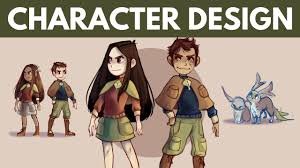How Do You Become A Game Art Director? Can I Be An Art Director With An Animation Degree?
Becoming a game art director is a rewarding career path for those who have a passion for both video games and art. Game art directors are responsible for overseeing the visual aspects of game development, including character design, environment creation, and user interface design. In this article, we will discuss the steps you can take to become a game art director.
Step 1: Obtain a Bachelor’s Degree
While it is possible to become a game art director without a formal education, having a bachelor’s degree in a related field can be highly beneficial. Most game art directors hold a degree in a field such as computer graphics, game design, or fine arts. These programs provide students with the necessary skills and knowledge to succeed in the gaming industry, including design principles, color theory, and 3D modeling.

Step 2: Build Your Portfolio
Game art directors must have a strong portfolio that showcases their skills and experience in the field. Aspiring game art directors should create a portfolio that highlights their best work, including examples of character design, environment creation, and user interface design. Portfolios can be created using a variety of tools, including digital platforms like ArtStation or personal websites.
Step 3: Gain Work Experience
Game art directors typically have several years of experience working in the gaming industry before moving into a leadership position. Aspiring game art directors should look for entry-level positions in the industry, such as 3D modeler or concept artist. These roles provide valuable experience and allow individuals to build their skills and develop a network of contacts within the industry.
Step 4: Develop Leadership Skills
Game art directors are responsible for leading a team of artists and designers to create the visual aspects of a game. As such, it is important for aspiring game art directors to develop strong leadership skills. These skills include effective communication, problem-solving, and the ability to motivate and inspire a team. Leadership skills can be developed through experience in the gaming industry, as well as through formal leadership training and development programs.
Step 5: Network
Networking is a crucial part of becoming a game art director. Attending industry events, conferences, and trade shows is a great way to meet other professionals in the field and learn about new developments in the industry. Networking can also lead to job opportunities, as many game art director positions are filled through personal contacts and referrals.

Step 6: Apply for Game Art Director Positions
Once you have gained the necessary skills, education, and experience, it’s time to start applying for game art director positions. Game art director positions are typically advertised on job boards, company websites, and industry-specific websites such as Gamasutra. Be sure to tailor your resume and cover letter to each position you apply for, highlighting your skills and experience that are most relevant to the job.
Conclusion
Becoming a game art director takes time and effort, but it can be a highly rewarding career for those who are passionate about both art and video games. To become a game art director, you should obtain a bachelor’s degree in a related field, build a strong portfolio, gain work experience, develop leadership skills, network, and apply for game art director positions. With persistence and dedication, you can achieve your goal of becoming a game art director and contribute to the development of some of the world’s most beloved video games.
Can I Be An Art Director With An Animation Degree?
Yes, it is possible to become an art director with an animation degree. Art directors are responsible for overseeing the visual aspects of a project, including the creation of characters, environments, and user interfaces. While some art directors have degrees specifically in art direction or a related field, others may have degrees in animation, game design, or fine arts.
Here are some steps you can take to become an art director with an animation degree:
Step 1: Build a Strong Portfolio
A strong portfolio is essential for any artist, regardless of their degree. As an animator, your portfolio should showcase your ability to create engaging characters, environments, and animations. It should also demonstrate your understanding of color theory, composition, and visual storytelling. Your portfolio can be created using a variety of tools, such as digital platforms like ArtStation or personal websites.

Step 2: Gain Work Experience
Gaining work experience in the animation industry can help you build your skills and develop a network of contacts. Entry-level positions, such as character animator or concept artist, can provide valuable experience and allow you to learn from experienced professionals. As you gain more experience, you may have the opportunity to take on leadership roles, such as a lead animator or art director.
Step 3: Develop Leadership Skills
Art directors must be effective leaders, able to inspire and motivate their team to create the best possible work. Developing strong leadership skills is essential for anyone looking to become an art director. Effective communication, problem-solving, and the ability to delegate tasks are just a few of the skills that art directors need to have. Leadership skills can be developed through experience in the animation industry, as well as through formal leadership training and development programs.
Step 4: Network
Networking is a crucial part of any creative industry, including animation. Attending industry events, conferences, and trade shows is a great way to meet other professionals in the field and learn about new developments in the industry. Networking can also lead to job opportunities, as many art director positions are filled through personal contacts and referrals.
Step 5: Consider Additional Education or Training
While an animation degree can provide a strong foundation for a career in art direction, additional education or training may be beneficial. Courses or workshops in art direction, leadership, or project management can help you develop the skills you need to succeed as an art director. Additionally, pursuing a master’s degree in art direction or a related field can provide you with more advanced training and education.

Conclusion
In conclusion, it is possible to become an art director with an animation degree. To succeed in this field, you should focus on building a strong portfolio, gaining work experience, developing leadership skills, networking, and considering additional education or training. With persistence and dedication, you can achieve your goal of becoming an art director and contribute to the creation of visually stunning projects.
Becoming a game art director is a rewarding career path for those who have a passion for both video games and art. Game art directors are responsible for overseeing the visual aspects of game development, including character design, environment creation, and user interface design. In this article, we will discuss the steps you can take to become a game art director.
Step 1: Obtain a Bachelor’s Degree
While it is possible to become a game art director without a formal education, having a bachelor’s degree in a related field can be highly beneficial. Most game art directors hold a degree in a field such as computer graphics, game design, or fine arts. These programs provide students with the necessary skills and knowledge to succeed in the gaming industry, including design principles, color theory, and 3D modeling.

Step 2: Build Your Portfolio
Game art directors must have a strong portfolio that showcases their skills and experience in the field. Aspiring game art directors should create a portfolio that highlights their best work, including examples of character design, environment creation, and user interface design. Portfolios can be created using a variety of tools, including digital platforms like ArtStation or personal websites.
Step 3: Gain Work Experience
Game art directors typically have several years of experience working in the gaming industry before moving into a leadership position. Aspiring game art directors should look for entry-level positions in the industry, such as 3D modeler or concept artist. These roles provide valuable experience and allow individuals to build their skills and develop a network of contacts within the industry.
Step 4: Develop Leadership Skills
Game art directors are responsible for leading a team of artists and designers to create the visual aspects of a game. As such, it is important for aspiring game art directors to develop strong leadership skills. These skills include effective communication, problem-solving, and the ability to motivate and inspire a team. Leadership skills can be developed through experience in the gaming industry, as well as through formal leadership training and development programs.
Step 5: Network
Networking is a crucial part of becoming a game art director. Attending industry events, conferences, and trade shows is a great way to meet other professionals in the field and learn about new developments in the industry. Networking can also lead to job opportunities, as many game art director positions are filled through personal contacts and referrals.

Step 6: Apply for Game Art Director Positions
Once you have gained the necessary skills, education, and experience, it’s time to start applying for game art director positions. Game art director positions are typically advertised on job boards, company websites, and industry-specific websites such as Gamasutra. Be sure to tailor your resume and cover letter to each position you apply for, highlighting your skills and experience that are most relevant to the job.
Conclusion
Becoming a game art director takes time and effort, but it can be a highly rewarding career for those who are passionate about both art and video games. To become a game art director, you should obtain a bachelor’s degree in a related field, build a strong portfolio, gain work experience, develop leadership skills, network, and apply for game art director positions. With persistence and dedication, you can achieve your goal of becoming a game art director and contribute to the development of some of the world’s most beloved video games.
Can I Be An Art Director With An Animation Degree?
Yes, it is possible to become an art director with an animation degree. Art directors are responsible for overseeing the visual aspects of a project, including the creation of characters, environments, and user interfaces. While some art directors have degrees specifically in art direction or a related field, others may have degrees in animation, game design, or fine arts.
Here are some steps you can take to become an art director with an animation degree:
Step 1: Build a Strong Portfolio
A strong portfolio is essential for any artist, regardless of their degree. As an animator, your portfolio should showcase your ability to create engaging characters, environments, and animations. It should also demonstrate your understanding of color theory, composition, and visual storytelling. Your portfolio can be created using a variety of tools, such as digital platforms like ArtStation or personal websites.

Step 2: Gain Work Experience
Gaining work experience in the animation industry can help you build your skills and develop a network of contacts. Entry-level positions, such as character animator or concept artist, can provide valuable experience and allow you to learn from experienced professionals. As you gain more experience, you may have the opportunity to take on leadership roles, such as a lead animator or art director.
Step 3: Develop Leadership Skills
Art directors must be effective leaders, able to inspire and motivate their team to create the best possible work. Developing strong leadership skills is essential for anyone looking to become an art director. Effective communication, problem-solving, and the ability to delegate tasks are just a few of the skills that art directors need to have. Leadership skills can be developed through experience in the animation industry, as well as through formal leadership training and development programs.
Step 4: Network
Networking is a crucial part of any creative industry, including animation. Attending industry events, conferences, and trade shows is a great way to meet other professionals in the field and learn about new developments in the industry. Networking can also lead to job opportunities, as many art director positions are filled through personal contacts and referrals.
Step 5: Consider Additional Education or Training
While an animation degree can provide a strong foundation for a career in art direction, additional education or training may be beneficial. Courses or workshops in art direction, leadership, or project management can help you develop the skills you need to succeed as an art director. Additionally, pursuing a master’s degree in art direction or a related field can provide you with more advanced training and education.

Conclusion
In conclusion, it is possible to become an art director with an animation degree. To succeed in this field, you should focus on building a strong portfolio, gaining work experience, developing leadership skills, networking, and considering additional education or training. With persistence and dedication, you can achieve your goal of becoming an art director and contribute to the creation of visually stunning projects.
Can I Be An Art Director With An Animation Degree?
Yes, it is possible to become an art director with an animation degree. Art directors are responsible for overseeing the visual aspects of a project, including the creation of characters, environments, and user interfaces. While some art directors have degrees specifically in art direction or a related field, others may have degrees in animation, game design, or fine arts.
Here are some steps you can take to become an art director with an animation degree:
Step 1: Build a Strong Portfolio
A strong portfolio is essential for any artist, regardless of their degree. As an animator, your portfolio should showcase your ability to create engaging characters, environments, and animations. It should also demonstrate your understanding of color theory, composition, and visual storytelling. Your portfolio can be created using a variety of tools, such as digital platforms like ArtStation or personal websites.

Step 2: Gain Work Experience
Gaining work experience in the animation industry can help you build your skills and develop a network of contacts. Entry-level positions, such as character animator or concept artist, can provide valuable experience and allow you to learn from experienced professionals. As you gain more experience, you may have the opportunity to take on leadership roles, such as a lead animator or art director.
Step 3: Develop Leadership Skills
Art directors must be effective leaders, able to inspire and motivate their team to create the best possible work. Developing strong leadership skills is essential for anyone looking to become an art director. Effective communication, problem-solving, and the ability to delegate tasks are just a few of the skills that art directors need to have. Leadership skills can be developed through experience in the animation industry, as well as through formal leadership training and development programs.
Step 4: Network
Networking is a crucial part of any creative industry, including animation. Attending industry events, conferences, and trade shows is a great way to meet other professionals in the field and learn about new developments in the industry. Networking can also lead to job opportunities, as many art director positions are filled through personal contacts and referrals.
Step 5: Consider Additional Education or Training
While an animation degree can provide a strong foundation for a career in art direction, additional education or training may be beneficial. Courses or workshops in art direction, leadership, or project management can help you develop the skills you need to succeed as an art director. Additionally, pursuing a master’s degree in art direction or a related field can provide you with more advanced training and education.

Conclusion
In conclusion, it is possible to become an art director with an animation degree. To succeed in this field, you should focus on building a strong portfolio, gaining work experience, developing leadership skills, networking, and considering additional education or training. With persistence and dedication, you can achieve your goal of becoming an art director and contribute to the creation of visually stunning projects.








